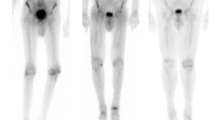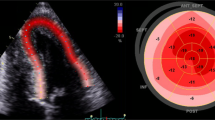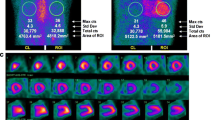Abstract
Purpose of Review
Cardiac amyloidosis is an infiltrative cardiomyopathy, most commonly due to light chain amyloidosis [AL] or transthyretin amyloidosis [ATTR]; both cause significant heart failure and mortality. This review is a comprehensive overview of radionuclide molecular imaging in cardiac amyloidosis, highlighting the latest advancements in aiding diagnosis and prognosis.
Recent Findings
Specific bone scintigraphy agents have a high sensitivity and specificity for the diagnosis of transthyretin cardiac amyloidosis. Amyloid-binding radiotracers, originally developed for imaging Alzheimer’s disease, are being employed to image light chain and transthyretin cardiac amyloidosis. There is ongoing research into the use of these tracers for precise quantification of cardiac amyloidosis, which can be used to guide therapy.
Summary
Radionuclide molecular imaging techniques have a vital role in advancing the field of cardiac amyloidosis. With a broadening armamentarium of novel radio tracers and new therapeutic developments, this is an exciting area, with potential breakthroughs on the horizon.


Similar content being viewed by others
References
Papers of particular interest, published recently, have been highlighted as: • Of importance
Falk RH. Diagnosis and management of the cardiac amyloidoses. Circulation. 2005;112(13):2047–60. https://doi.org/10.1161/CIRCULATIONAHA.104.489187.
Ruberg FL, Berk JL. Transthyretin (TTR) cardiac amyloidosis. Circulation. 2012;126(10):1286–300. https://doi.org/10.1161/CIRCULATIONAHA.111.078915.
Alexander KM, Singh A, Falk RH. Novel pharmacotherapies for cardiac amyloidosis. Pharmacol Ther. 2017;180:129–38. https://doi.org/10.1016/j.pharmthera.2017.06.011.
Dorbala S, Kijewski MF, Park MA. Quantitative molecular imaging of cardiac amyloidosis: the journey has begun. J Nucl Cardiol. 2015;23:751–3. https://doi.org/10.1007/s12350-015-0235-z.
Falk RH, Quarta CC, Dorbala S. How to image cardiac amyloidosis. Circ Cardiovasc Imaging. 2014;7(3):552–62. https://doi.org/10.1161/CIRCIMAGING.113.001396.
Bravo PE, Dorbala S. Targeted nuclear imaging probes for cardiac amyloidosis. Curr Cardiol Rep. 2017;19(7):59. https://doi.org/10.1007/s11886-017-0868-4.
Dorbala Sharmila, Bokhari Sabahat, Miller Edward, Bullock-Palmer Renee, Soman Prem, Thompson Randall. 2016. ASNC Practice Points: 99mTechnetium-Pyrophosphate Imaging for Transthyretin Cardiac Amyloidosis. Online: American Society of Nuclear Cardiology. https://www.asnc.org/Files/Practice%20Resources/Practice%20Points/ASNC%20Practice%20Point-99mTechnetiumPyrophosphateImaging2016.pdf. Accessed August 17 2017
Pepys MB, Dyck RF, de Beer FC, Skinner M, Cohen AS. Binding of serum amyloid P-component (SAP) by amyloid fibrils. Clin Exp Immunol. 1979;38(2):284–93.
Bokhari S, Shahzad R, Maurer M. Radionuclide imaging in cardiac amyloidosis: are nuclear bone tracers a foreseeable future? Current Cardiovascular Imaging Reports. 2015;8(3). doi:https://doi.org/10.1007/s12410-015-9344-y.
• Gillmore JD, Maurer MS, Falk RH, Merlini G, Damy T, Dispenzieri A, et al. Nonbiopsy diagnosis of cardiac transthyretin amyloidosis. Circulation. 2016;133(24):2404–12. https://doi.org/10.1161/CIRCULATIONAHA.116.021612. This is the largest experience to date compiling data from multiple centers and showing the high accuracy of bone imaging in the diagnosis of ATTR cardiac amyloidosis
Lee VW, Caldarone AG, Falk RH, Rubinow A, Cohen AS. Amyloidosis of heart and liver: comparison of Tc-99m pyrophosphate and Tc-99m methylene diphosphonate for detection. Radiology. 1983;148(1):239–42. https://doi.org/10.1148/radiology.148.1.6304810.
Bokhari S, Castano A, Pozniakoff T, Deslisle S, Latif F, Maurer MS. (99m)Tc-pyrophosphate scintigraphy for differentiating light-chain cardiac amyloidosis from the transthyretin-related familial and senile cardiac amyloidoses. Circ Cardiovasc Imaging. 2013;6(2):195–201. https://doi.org/10.1161/CIRCIMAGING.112.000132.
Castano A, Haq M, Narotsky DL, Goldsmith J, Weinberg RL, Morgenstern R, et al. Multicenter study of planar technetium 99m pyrophosphate cardiac imaging: predicting survival for patients with ATTR cardiac amyloidosis. JAMA Cardiol. 2016;1:880–9. https://doi.org/10.1001/jamacardio.2016.2839.
Sperry BW, Vranian MN, Tower-Rader A, Hachamovitch R, Hanna M, Brunken R, et al. Regional variation in technetium pyrophosphate uptake in transthyretin cardiac amyloidosis and impact on mortality. J Am Coll Cardiol Img. 2018;11(2 Pt 1):234–42. https://doi.org/10.1016/j.jcmg.2017.06.020.
Castano A, DeLuca A, Weinberg R, Pozniakoff T, Blaner WS, Pirmohamed A, et al. Serial scanning with technetium pyrophosphate ((99m)Tc-PYP) in advanced ATTR cardiac amyloidosis. J Nucl Cardiol. 2016;23(6):1355–63. https://doi.org/10.1007/s12350-015-0261-x.
Gagliardi C, Tabacchi E, Bonfiglioli R, Diodato S, Nanni C, Guidalotti P, et al. Does the etiology of cardiac amyloidosis determine the myocardial uptake of [18F]-NaF PET/CT? J Nucl Cardiol. 2016;24:746–9. https://doi.org/10.1007/s12350-016-0457-8.
Van Der Gucht A, Galat A, Rosso J, Guellich A, Garot J, Bodez D, et al. [18F]-NaF PET/CT imaging in cardiac amyloidosis. J Nucl Cardiol. 2016;23(4):846–9. https://doi.org/10.1007/s12350-015-0287-0.
Morgenstern R, Yeh R, Castano A, Maurer MS, Bokhari S. (18)Fluorine sodium fluoride positron emission tomography, a potential biomarker of transthyretin cardiac amyloidosis. J Nucl Cardiol. 2017; https://doi.org/10.1007/s12350-017-0799-x.
Noordzij W, Glaudemans AW, van Rheenen RW, Hazenberg BP, Tio RA, Dierckx RA, et al. (123)I-labelled metaiodobenzylguanidine for the evaluation of cardiac sympathetic denervation in early stage amyloidosis. Eur J Nucl Med Mol Imaging. 2012;39(10):1609–17. https://doi.org/10.1007/s00259-012-2187-8.
Trivieri MG, Dweck MR, Abgral R, Robson PM, Karakatsanis NA, Lala A, et al. (18)F-sodium fluoride PET/MR for the assessment of cardiac amyloidosis. J Am Coll Cardiol. 2016;68(24):2712–4. https://doi.org/10.1016/j.jacc.2016.09.953.
Klunk WE, Engler H, Nordberg A, Wang Y, Blomqvist G, Holt DP, et al. Imaging brain amyloid in Alzheimer’s disease with Pittsburgh compound-B. Ann Neurol. 2004;55(3):306–19. https://doi.org/10.1002/ana.20009.
• Law WP, Wang WY, Moore PT, Mollee PN, Ng AC. Cardiac amyloid imaging with 18F-florbetaben positron emission tomography: a pilot study. J Nucl Med. 2016;57:1733–9. https://doi.org/10.2967/jnumed.115.169870. This was the first publication to show the value of 18F-florbetaben to image cardiac amyloidosis.
• Dorbala S, Vangala D, Semer J, Strader C, Bruyere JR Jr, Di Carli MF, et al. Imaging cardiac amyloidosis: a pilot study using (18)F-florbetapir positron emission tomography. Eur J Nucl Med Mol Imaging. 2014;41(9):1652–62. https://doi.org/10.1007/s00259-014-2787-6. This was the first publication to show the value of 18F-florbetapir to image cardiac amyloidosis
Vandenberghe R, Van Laere K, Ivanoiu A, Salmon E, Bastin C, Triau E, et al. 18F-flutemetamol amyloid imaging in Alzheimer disease and mild cognitive impairment: a phase 2 trial. Ann Neurol. 2010;68(3):319–29. https://doi.org/10.1002/ana.22068.
Svedberg MM, Hall H, Hellstrom-Lindahl E, Estrada S, Guan Z, Nordberg A, et al. [(11)C]PIB-amyloid binding and levels of Abeta40 and Abeta42 in postmortem brain tissue from Alzheimer patients. Neurochem Int. 2009;54(5–6):347–57. https://doi.org/10.1016/j.neuint.2008.12.016.
• Antoni G, Lubberink M, Estrada S, Axelsson J, Carlson K, Lindsjo L, et al. In vivo visualization of amyloid deposits in the heart with 11C-PIB and PET. J Nucl Med. 2013;54(2):213–20. https://doi.org/10.2967/jnumed.111.102053. This was the first publication showing the value of 11C-PIB to image cardiac amyloidosis
• Lee SP, Lee ES, Choi H, Im HJ, Koh Y, Lee MH, et al. (11)C-Pittsburgh B PET imaging in cardiac amyloidosis. J Am Coll Cardiol Img. 2015;8(1):50–9. https://doi.org/10.1016/j.jcmg.2014.09.018. This was the first publication showing differences in 11C-PIB uptake among patients with and without prior chemotherapy
Kero T, Lindsjo L, Sorensen J, Lubberink M. Accurate analysis and visualization of cardiac (11)C-PIB uptake in amyloidosis with semiautomatic software. J Nucl Cardiol. 2016;23(4):741–50. https://doi.org/10.1007/s12350-015-0149-9.
Lin KJ, Hsu WC, Hsiao IT, Wey SP, Jin LW, Skovronsky D, et al. Whole-body biodistribution and brain PET imaging with [18F]AV-45, a novel amyloid imaging agent—a pilot study. Nucl Med Biol. 2010;37(4):497–508. https://doi.org/10.1016/j.nucmedbio.2010.02.003.
Clark CM, Schneider JA, Bedell BJ, Beach TG, Bilker WB, Mintun MA, et al. Use of florbetapir-PET for imaging beta-amyloid pathology. JAMA. 2011;305(3):275–83. https://doi.org/10.1001/jama.2010.2008.
• Park MA, Padera RF, Belanger A, Dubey S, Hwang DH, Veeranna V et al. 18F-florbetapir binds specifically to myocardial light chain and transthyretin amyloid deposits: autoradiography study. Circulation Cardiovascular Imaging. 2015;8(8). doi:https://doi.org/10.1161/CIRCIMAGING.114.002954. This was the first publication demonstrating specific binding of 18F-florbetapir to myocardial AL and ATTR deposits.
Hawkins PN, Aprile C, Capri G, Vigano L, Munzone E, Gianni L, et al. Scintigraphic imaging and turnover studies with iodine-131 labelled serum amyloid P component in systemic amyloidosis. Eur J Nucl Med. 1998;25(7):701–8.
Hawkins PN, Lavender JP, Pepys MB. Evaluation of systemic amyloidosis by scintigraphy with 123I-labeled serum amyloid P component. N Engl J Med. 1990;323(8):508–13. https://doi.org/10.1056/NEJM199008233230803.
Hazenberg BP, van Rijswijk MH, Piers DA, Lub-de Hooge MN, Vellenga E, Haagsma EB, et al. Diagnostic performance of 123I-labeled serum amyloid P component scintigraphy in patients with amyloidosis. Am J Med. 2006;119(4):355 e15–24. https://doi.org/10.1016/j.amjmed.2005.08.043.
Wall JS, Kennel SJ, Stuckey AC, Long MJ, Townsend DW, Smith GT, et al. Radioimmunodetection of amyloid deposits in patients with AL amyloidosis. Blood. 2010;116(13):2241–4. https://doi.org/10.1182/blood-2010-03-273797.
Saido T, Leissring MA. Proteolytic degradation of amyloid beta-protein. Cold Spring Harb Perspect Med. 2012;2(6):a006379. https://doi.org/10.1101/cshperspect.a006379.
Sojan SM, Smyth DR, Tsopelas C, Mudge D, Collins PJ, Chatterton BE. Pharmacokinetics and normal scintigraphic appearance of 99mTc aprotinin. Nucl Med Commun. 2005;26(6):535–9.
Han S, Chong V, Murray T, McDonagh T, Hunter J, Poon FW, et al. Preliminary experience of 99mTc-Aprotinin scintigraphy in amyloidosis. Eur J Haematol. 2007;79(6):494–500. https://doi.org/10.1111/j.1600-0609.2007.00963.x.
Kozak RW, Golker CF, Stadler P. Transmissible spongiform encephalopathies (TSE): minimizing the risk of transmission by biological/biopharmaceutical products: an industry perspective. Dev Biol Stand. 1996;88:257–64.
Lekakis J, Dimopoulos M, Nanas J, Prassopoulos V, Agapitos N, Alexopoulos G, et al. Antimyosin scintigraphy for detection of cardiac amyloidosis. Am J Cardiol. 1997;80(7):963–5.
Coutinho MC, Cortez-Dias N, Cantinho G, Conceicao I, Oliveira A, Bordalo e Sa A, et al. Reduced myocardial 123-iodine metaiodobenzylguanidine uptake: a prognostic marker in familial amyloid polyneuropathy. Circ Cardiovasc Imaging. 2013;6(5):627–36. https://doi.org/10.1161/CIRCIMAGING.112.000367.
Chen W, Cao Q, Dilsizian V. Variation of heart-to-mediastinal ratio in (123)I-mIBG cardiac sympathetic imaging: its affecting factors and potential corrections. Curr Cardiol Rep. 2011;13(2):132–7. https://doi.org/10.1007/s11886-010-0157-y.
Author information
Authors and Affiliations
Corresponding author
Ethics declarations
Conflict of Interest
Rodney Falk reports grants from the National Institutes of Health, during the conduct of study, as well as grants from Glaxo Smith Kline, Pfizer, Alnylam, MedPace, and Icon, outside of the submitted work.
Sharmila Dorbala reports grants from the National Institutes of Health and American Heart Association, during the conduct of study.
Sarah Cuddy declares that she has no conflict of interest.
Human and Animal Rights and Informed Consent
This article does not contain any studies with human or animal subjects performed by any of the authors.
Additional information
This article is part of the Topical Collection on Molecular Imaging
Rights and permissions
About this article
Cite this article
Cuddy, S., Falk, R. & Dorbala, S. Molecular Imaging of Cardiac Amyloidosis. Curr Cardiovasc Imaging Rep 11, 17 (2018). https://doi.org/10.1007/s12410-018-9457-1
Published:
DOI: https://doi.org/10.1007/s12410-018-9457-1




